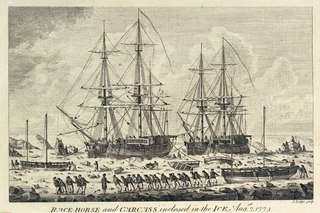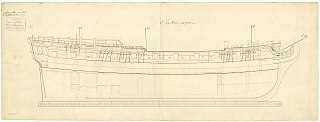
HMS Zebra was a 16-gun Zebra-class sloop of the Royal Navy, launched on 31 August 1780 at Gravesend. She was the second ship to bear the name. After twenty years of service, including involvement in the West Indies campaigns during the French Revolutionary Wars, she was converted into a bomb vessel in 1798. In this capacity she took part in attacks on French ports, and was present at both battles of Copenhagen. The Navy sold her in 1812.

HMS Carcass was an Infernal-class bomb vessel of the Royal Navy, later refitted as a survey vessel. A young Horatio Nelson served aboard her as a midshipman on an expedition to the Arctic in 1773.

HMS Seahorse was a 24-gun sixth-rate frigate of the Royal Navy, launched in 1748. She is perhaps most famous as the ship on which a young Horatio Nelson served as a midshipman. She also participated in four battles off the coast of India between 1781 and 1783. The Royal Navy sold her in 1784 and she then became the mercantile Ravensworth. She made one voyage for the British East India Company (EIC) between 1786 and 1788. In 1789, she was sold to the French East India Company which had her refitted and renamed her Citoyen. In 1793 the French Navy purchased her and used her as a frigate. She was last listed in 1801.
HMS Boreas was a 28-gun Coventry-class sixth-rate frigate of the Royal Navy. Built by Israel Pownoll at Woolwich Dockyard and launched in 1757, she was one of five frigates of the class built of fir rather than oak. Boreas saw service during the Seven Years' War and took part in two actions at sea. She assisted in the capture of the 36-gun French frigate Diane in April 1758, and her most famous engagement was the capture of the French frigate Sirène in October 1760. She was sold out of the service in 1770.
HMS Valeur was a 28-gun sixth-rate frigate of the Royal Navy, initially launched in 1754 as the Valeur for the French Navy, and classified by them as a corvette. The British captured her in 1759. In Royal Navy service she captured several merchant vessels and privateers before she was sold in 1764.
HMS Squirrel was a Royal Navy sixth rate post ship, built in 1755. She served during the French and Indian War, most notably at Louisbourg and Quebec, and the American Revolution, during which she captured two French privateers. The Royal Navy sold her in 1783. J. Montgomery purchased her and she became the Greenland whaler Union. Then in 1790–91 she became a slaver, making five slave-trading voyages. Between 1796 and 1802 she made two voyages for the British East India Company (EIC). She then traded between London and Liverpool. She was last listed in 1804.
HMS Leith, also known as HM hired armed ship Leith, was launched in 1744 or 1746 in the British "Plantations", more specifically, the colony of Maryland. From 1764 to 1777 she was a Greenlandman, that is a whaler, in the waters east of Greenland. Between 1777 and 1782 she served the Royal Navy as a transport and hired armed naval ship. She was last listed in 1783.
HMS Infernal was an 8-gun bomb vessel of the Royal Navy, constructed in 1757 and in service until 1763. Designed by Thomas Slade, she was the prototype for six subsequent Infernal class bomb vessels which saw service in the Mediterranean and the West Indies during the Seven Years' War with France. In 1760 she was refitted as a sloop and returned to active service in the Caribbean.
HMS Curlew was the mercantile sloop Leander, launched at South Shields in 1800. The Royal Navy purchased her in 1803 and named her Curlew as there was already a HMS Leander in service, and the Curlew name was available. Curlew was a sloop of 16 guns. The Navy sold her in 1810 and she returned to mercantile service as Leander. On her first voyage to the West Indies a French privateer captured her in a single-ship action; she was lost shortly thereafter.
HMS Nimrod was a brig-sloop of the British Royal Navy, launched in 1812. She spent her war years in North American waters, where she captured one small privateer, assisted in the capture of another, and captured or destroyed some 50 American vessels. After the war she captured smugglers and assisted the civil authorities in maintaining order in Tyne. She was wrecked in 1827 and so damaged that the Navy decided she was not worth repairing. A private ship-owner purchased Nimrod and repaired her. She then went on to spend some 20 years trading between Britain and Charleston, the Mediterranean, Australia, and India. She was last listed in 1851.
HMS Terror was bomb vessel launched in 1741, converted to a sloop, and sold in 1754. She went into mercantile service, becoming the northern whale fishery whaler Duke of York. In 1784 her name changed to Elizabeth and Margaret, and she continued as a Greenland whaler, before becoming a whaler in the British southern whale fishery. She was last listed in 1794.
HMS Hazard was launched in 1749 For the Royal Navy as brig-rigged sloop. She had a 30-plus year career with the navy, during which she captured several small French privateers. At the end of the American War of Independence, the navy sold her and she became the merchantman Joseph. After almost a decade as a merchantman trading with Spain, a new owner made a whaler of her. She made seven whaling voyages and was no longer listed after 1804, two years after her return from her last whaling voyage.
HMS Autumn was launched at Shields in 1800 as a merchantman. The Royal Navy purchased her in 1801. The Navy sold her in 1815 and she returned to mercantile service. She was lost in 1818.
HMS Camel was the mercantile Yorkshire, which the Royal Navy purchased for use as a sixth-rate frigate. She captured a few merchant vessels in the West Indies, but spent most of her service escorting convoys across the Atlantic. She was converted to an armed transport in 1782–83. The Navy sold her in 1784.

HMS Terror was an 8-gun bomb ketch launched in 1759 for the British Royal Navy that it sold in 1774. New owners renamed her Union. She made two voyages as a Greenland whaler before becoming a London-based transport. She remained a transport until she was lost on 20 May 1782 off the Malabar coast of India.
HMS Garland was a frigate of the British Royal Navy, launched at Sheerness in 1748. She had an apparently uneventful career in the Royal Navy, not being listed as participating in engagements or battles. She did capture some French and American merchant vessels. Her most important capture in 1782, was that of the privateer Fair American, which had in some two years captured over 40 British vessels. The Navy sold her in 1783 and she became a slave ship, making six full voyages in the triangular trade in enslaved people. She was wrecked as she started for home having delivered the captives from her seventh voyage.
Mentor was the former HMS Wasp. The British Royal Navy sold Wasp in 1781 and she became the mercantile Polly, which traded with Africa. In 1784 Polly became the slave ship Mentor. Mentor made eight full voyages in the triangular trade in enslaved people. She carried captives from The Gambia to the West Indies. French privateers captured her in late 1795 as she was on her way from West Africa to the West Indies on her ninth voyage.
HMS Spy was a Bonetta-class sloop launched at Rotherhithe in 1756 for the Royal Navy. The Navy sold her in 1773. From 1776, or perhaps earlier she was a transport. Then from 1780 to 1783, as Mars, she was first a privateer and then a slave ship, engaged in the triangular trade in enslaved persons. Between 1783 and 1787 her name was Tartar, and she traded with the Mediterranean. From 1787, as Southampton, she was a whaler in the British southern whale fishery. She made at least four complete whaling voyages and was last listed in 1792.
Two vessels of the Royal Navy have been named HMS Granado :
Chaser was built in the East Indies in 1778. The Royal Navy purchased her in 1781 and commissioned her as HMS Chaser. A French frigate captured her in 1782 but the Royal Navy recaptured her in 1783 and took her back into service. She was present at a major battle and then sailed to England where the Navy sold her in 1784. As the mercantile Chaser she made five or six voyages as a whaler in the British northern whale fishery and then two to the southern whale fishery. On her way home from the second a French privateer captured her, but some of her crew recaptured her. Next, she began trading with Honduras but was wrecked in late 1795 as she was returning from there to London.








